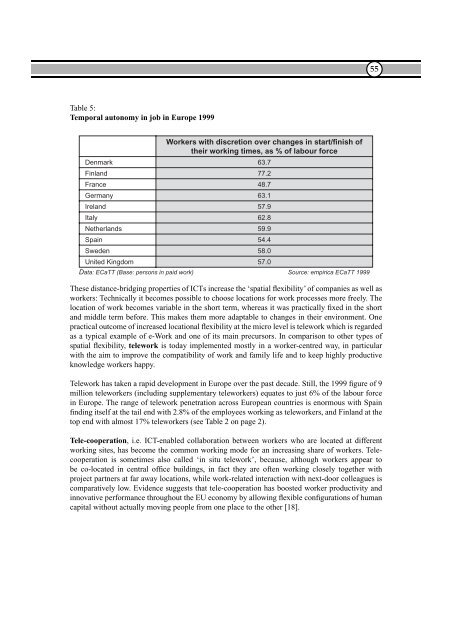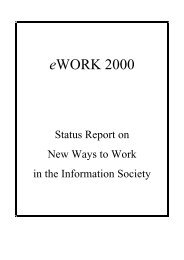Proceedings of 8th European Assembly on telework (Telework2001)
Proceedings of 8th European Assembly on telework (Telework2001)
Proceedings of 8th European Assembly on telework (Telework2001)
You also want an ePaper? Increase the reach of your titles
YUMPU automatically turns print PDFs into web optimized ePapers that Google loves.
55Table 5:Temporal aut<strong>on</strong>omy in job in Europe 1999Workers with discreti<strong>on</strong> over changes in start/finish <str<strong>on</strong>g>of</str<strong>on</strong>g>their working times, as % <str<strong>on</strong>g>of</str<strong>on</strong>g> labour forceDenmark 63.7Finland 77.2France 48.7Germany 63.1Ireland 57.9Italy 62.8Netherlands 59.9Spain 54.4Sweden 58.0United Kingdom 57.0Data: ECaTT (Base: pers<strong>on</strong>s in paid work) Source: empirica ECaTT 1999These distance-bridging properties <str<strong>on</strong>g>of</str<strong>on</strong>g> ICTs increase the ‘spatial flexibility’ <str<strong>on</strong>g>of</str<strong>on</strong>g> companies as well asworkers: Technically it becomes possible to choose locati<strong>on</strong>s for work processes more freely. Thelocati<strong>on</strong> <str<strong>on</strong>g>of</str<strong>on</strong>g> work becomes variable in the short term, whereas it was practically fixed in the shortand middle term before. This makes them more adaptable to changes in their envir<strong>on</strong>ment. Onepractical outcome <str<strong>on</strong>g>of</str<strong>on</strong>g> increased locati<strong>on</strong>al flexibility at the micro level is <strong>telework</strong> which is regardedas a typical example <str<strong>on</strong>g>of</str<strong>on</strong>g> e-Work and <strong>on</strong>e <str<strong>on</strong>g>of</str<strong>on</strong>g> its main precursors. In comparis<strong>on</strong> to other types <str<strong>on</strong>g>of</str<strong>on</strong>g>spatial flexibility, <strong>telework</strong> is today implemented mostly in a worker-centred way, in particularwith the aim to improve the compatibility <str<strong>on</strong>g>of</str<strong>on</strong>g> work and family life and to keep highly productiveknowledge workers happy.Telework has taken a rapid development in Europe over the past decade. Still, the 1999 figure <str<strong>on</strong>g>of</str<strong>on</strong>g> 9milli<strong>on</strong> <strong>telework</strong>ers (including supplementary <strong>telework</strong>ers) equates to just 6% <str<strong>on</strong>g>of</str<strong>on</strong>g> the labour forcein Europe. The range <str<strong>on</strong>g>of</str<strong>on</strong>g> <strong>telework</strong> penetrati<strong>on</strong> across <str<strong>on</strong>g>European</str<strong>on</strong>g> countries is enormous with Spainfinding itself at the tail end with 2.8% <str<strong>on</strong>g>of</str<strong>on</strong>g> the employees working as <strong>telework</strong>ers, and Finland at thetop end with almost 17% <strong>telework</strong>ers (see Table 2 <strong>on</strong> page 2).Tele-cooperati<strong>on</strong>, i.e. ICT-enabled collaborati<strong>on</strong> between workers who are located at differentworking sites, has become the comm<strong>on</strong> working mode for an increasing share <str<strong>on</strong>g>of</str<strong>on</strong>g> workers. Telecooperati<strong>on</strong>is sometimes also called ‘in situ <strong>telework</strong>’, because, although workers appear tobe co-located in central <str<strong>on</strong>g>of</str<strong>on</strong>g>fice buildings, in fact they are <str<strong>on</strong>g>of</str<strong>on</strong>g>ten working closely together withproject partners at far away locati<strong>on</strong>s, while work-related interacti<strong>on</strong> with next-door colleagues iscomparatively low. Evidence suggests that tele-cooperati<strong>on</strong> has boosted worker productivity andinnovative performance throughout the EU ec<strong>on</strong>omy by allowing flexible c<strong>on</strong>figurati<strong>on</strong>s <str<strong>on</strong>g>of</str<strong>on</strong>g> humancapital without actually moving people from <strong>on</strong>e place to the other [18].








